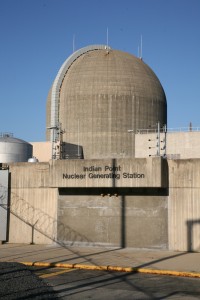
At a Jan. 12 hearing on Indian Point”™s future held in New York City, industry representatives urged lawmakers to account for the downstate region”™s high electricity demands while environmental groups continued to press for the plant”™s closure.
The joint hearing, hosted by the state Assembly committees on Energy and on Corporations, Authorities and Commissions, came on the heels of a Jan. 10 pump malfunction that shut down Indian Point Energy Center”™s unit 2 reactor.
As of Jan. 18, Entergy Corp. spokesman Jerry Nappi said the plant anticipated bringing the reactor back online by the end of last week.
Assembly members Kevin Cahill and James Brennan called the hearing to establish how the possible closure of Indian Point would impact electricity providers and consumers.
“(The) hearing clearly demonstrated that with proper planning there are a number of scenarios that could allow Indian Point to be shut down without unduly burdening New York”™s ratepayers or electric system,” Cahill, who chairs the Energy committee, said in a statement.
Currently, Indian Point generates between 25 and 30 percent of the electricity consumed in the lower Hudson Valley and New York City.
Entergy submitted a license renewal application to the Nuclear Regulatory Commission in 2007 for its two reactors, where the current licenses are scheduled to expire in September 2013 and December 2015, respectively.
The Atomic Safety and Licensing Board of the NRC is expected to begin hearings this year on several arguments that have been raised by environmental organizations and government officials regarding Indian Point”™s license renewal applications.
The New York State Department of Environmental Conservation is also in the process of conducting hearings on the plant”™s Water Quality Certification and its State Pollution Discharge Elimination Certificate, which have both been under way since last year.
Environmental advocates and several state government officials have argued the plant should be shut down, pointing to incidents like the Jan. 10 pump malfunction and noting the plant”™s proximity to the New York City metro area.
However, a review of the prepared testimonies of several industry representatives revealed a number of concerns.
Notably, based on the prepared statements from the hearing, representatives from Con Edison and the New York Independent System Operator ”“ the independent organization charged with managing the state”™s electric grid ”“ cautioned that if Indian Point”™s reactors are taken offline without equivalent alternative power sources already in place, demand will overwhelm supply in the downstate region.
“Our studies have found that, absent Indian Point or absent adequate replacement resources, there would be a deficiency of over 1,200 megawatts by the summer of 2016, and this deficiency would increase over time,” said Rick Gonzales, senior vice president and COO for NYISO. “Simply put, this means that adequate replacement resources are required prior to a closure of Indian Point, otherwise New York will not meet its reliability standards.”
Joseph P. Oates, Con Edison”™s Vice President for Energy Management, echoed the Gonzales”™ concerns.
“New facilities and infrastructure must be built and placed into service before a permanent shutdown can happen; this means that replacement resources would need to be designed, receive all required permits, be constructed, tested and placed into operation to avoid reliability criteria violations,” Oates said.
Both Gonzales and Oates said that removing Indian Point”™s generating capacity from the grid could result in price increases and possible electricity disruptions.
Entergy representatives have repeatedly stressed that, in addition to being an inexpensive, environmentally friendly source of electricity, the plant has been one of the country”™s top-performing nuclear generating facilities over the past several years, with numerous safeguards in place to prevent an incident from affecting neighboring towns.
“Alternatives to Indian Point would increase electric rates, will likely decrease reliability, and will likely increase air pollution,” said Mike Twomey, vice president of external affairs for Entergy Wholesale Commodities, according to his prepared statements.


















